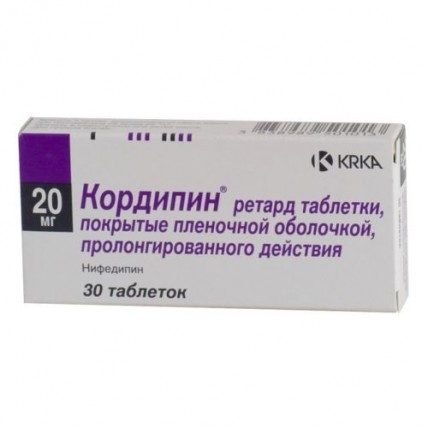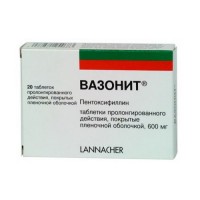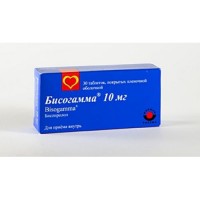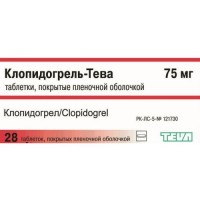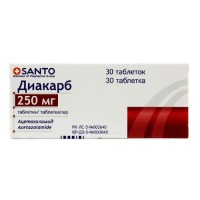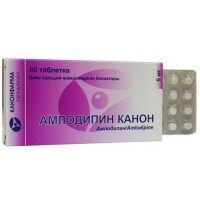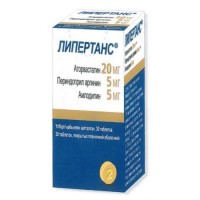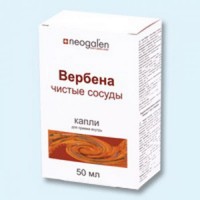Cordipin 20 mg coated (30 tablets)
- $10.90
Out Of Stock
KordipinMezhdunarodnyy name:
Nifedipine Group accessory:
BMKK
Description of active ingredient (MNN):
NifedipinLekarstvennyy form:
a dragee, drops for intake, capsules, solution for infusions, tablets, tablets coated, tablets of the prolonged action, tablets of the prolonged action coated, tablets slow motion-retard, tablets with controlled vysvobopharmakologichesky action:
Selection BMKK, derivative 1.4 dihydropyridines. Has vazodilatiruyushchy, anti-anginal and hypotensive effect. Reduces Ca2 current + in cardiomyocytes and smooth muscle cells of coronary and peripheral arteries, in high doses suppresses release of Ca2 + from intracellular depots. Reduces the number of the functioning channels, without making impact on time of their activation, an inactivation and restoration. Separates the processes of excitement and reduction in a myocardium mediated by tropomyosine and troponiny, and in unstriated muscles of vessels, mediated by a calmodulin. In therapeutic doses normalizes the transmembrane current of Ca2+ broken at a number of morbid conditions, first of all in arterial hypertension. Does not influence a tone of veins. Strengthens a coronary blood stream, improves blood supply of ischemic zones of a myocardium without development of a phenomenon of 'burglarizing', activates functioning of collaterals. Expanding peripheral arteries, reduces OPSS, a myocardium tone, an afterload, the need of a myocardium for oxygen and increases duration of diastolic relaxation of LZh. Practically does not influence SA and AV nodes and has no antiarrhytmic activity. Strengthens a renal blood stream, causes a moderate natriuresis. Negative hrono-, dromo- and inotropic action is blocked by reflex activation of a sympathoadrenal system and increase in ChSS in response to a peripheral vazodilatation. Time of approach of effect: 20 min. - at oral administration, 5 min. - at sublingual reception of contents of capsules, effect duration: 4-6 h - for tablets and capsules, 12-24 h - for the prolonged forms. Indications:
Stenocardia (tension, stable without vasomotor spasm, stable vasospastic, unstable vasospastic at inefficiency of beta blockers and nitrates), arterial hypertension (including renovascular), stopping of hypertensive crisis, a disease and Reynaud's syndrome, a spasm of coronary arteries (during diagnostic or therapeutic interventions - percutaneous transluminal coronary angioplasty, a rekanalization of vessels or aortocoronary shunting), differential diagnostics between a functional and organic stricture of coronary arteries, hypertensia in a 'small' circle of blood circulation. Contraindications:
Hypersensitivity, heavy arterial hypotension (systolic arterial blood pressure is lower than 90 mm Hg.), pregnancy, lactation period. With care. The profound stenosis of the mouth of an aorta or the mitral valve, GOKMP, the profound bradycardia or tachycardia, SSSU, HSN, slight or moderate arterial hypotension, heavy disturbances of cerebral circulation, a myocardial infarction with LZh insufficiency, impassability of a GIT (for forms with the slowed-down release), a liver failure, a renal failure (especially the patients who are on a hemodialysis, - high risk of the excessive and not predicted decrease in the ABP), advanced age, children's age up to 18 years (the efficiency and safety of use are not investigated). Side effects:
From CCC: tachycardia, arrhythmias, peripheral hypostases (anklebones, feet, shins), manifestations of an excessive vazodilatation (asymptomatic decrease in the ABP, 'inflows' of blood to face skin, a dermahemia of the person, feeling of heat), excessive decrease in the ABP (rarely), a syncope, development or aggravation of SN (aggravation of already being available is more often). At some patients (especially with crushing obstructive damage of coronary arteries) in an initiation of treatment or at increase in a dose the emergence of attacks of stenocardia is possible, up ment of a myocardial infarction (demands drug withdrawal). From nervous system: headache, dizziness, increased fatigue, asthenia, drowsiness. At chronic ingestion in high doses - paresthesias of extremities, a tremor, extrapyramidal (parkinsonichesky) disturbances (the ataxy, a mask-like face shuffling gait, rigidity of hands or legs, a tremor of brushes and fingers of hands, swallowing difficulty), a depression. From digestive system: dryness in a mouth, increase in appetite, dyspepsia (nausea, diarrhea or a constipation), is rare - a hyperplasia of gums (bleeding, morbidity, puffiness), at long reception - abnormal liver functions (intra hepatic cholestasia, increase in activity of 'hepatic' transaminases). From the musculoskeletal system: seldom - an arthralgia, puffiness of joints, myalgia. From bodies of a hemopoiesis: anemia, leukopenia, thrombocytopenia, Werlhof's disease, asymptomatic agranulocytosis. From an urinary system: increase in a daily urine, deterioration in function of kidneys (at patients with a renal failure). Allergic reactions: seldom - a skin itching, a small tortoiseshell, a dieback, autoimmune hepatitis. Local reactions: burning in the place in/in introductions. Other: seldom - disorders of vision (including tranzitorny loss of sight against the background of Cmax in plasma), a gynecomastia (at elderly patients, completely disappearing after cancellation), a galactorrhoea, a hyperglycemia, a fluid lungs (breath difficulty, cough, stidor breath), increase in body weight. Overdose. Symptoms: headache, dermahemia of the person, long significant decrease in the ABP, suppression of function of a sinus node, bradycardia, bradyarrhythmia. Treatment: in a serious poisoning (collapse, oppression of a sinus node) carry out gastric lavage, appoint activated carbon. Antidote are the drugs Ca2+: 10% of CaCl2, slow in/in introduction, or calcium of a gluconate, with the subsequent switching to long infusion are shown. At the significant decrease in the ABP - in/in introduction of a dopamine or Dobutaminum. At disturbances of conductivity - atropine, izoprenalin or an artificial pacemaker. At development of SN - in/in administration of strophanthin. Catecholamines should be applied only at threat of life (in connection with their lowered efficiency the high dosage is required owing to what the danger of development of arrhythmia increases). Control of concentration in glucose blood is recommended (insulin release) and electrolytes (K+, Ca2+ can decrease). The hemodialysis is inefficient. Route of administration and doses:
Inside, sublingual, in/in, vnutrikoronarno. The maximum daily dose of short-range nifedipine - 40 mg. For constant reception use of the prolonged nifedipine forms, maximum a single dose - 30 mg, a daily dose - 180 mg is recommended. Sublingual: in hypertensive crisis - on 10 mg every 30 min. (in a total dose up to 40 mg) under careful control of the ABP and ChSS. After reception it is recommended to the patient to be in situation 'lying' within 30-60 min. Inside, in time or after meal, washing down with a small amount of water, 10 mg 2-4 times a day. At insufficient expressiveness of effect the increase in a dose of drug (on condition of transition to the prolonged forms) to 80-120 mg/days (depending on drug) within 7-14 days is possible. In an angina of exertion it is recommended to begin therapy with 10 mg 3 times a day, with gradual increase in a dose by 10 mg in 4-5 days. In vasospastic stenocardia appoint the prolonged forms in a dose from 80 mg/days. At other genesis of unstable stenocardia - only in combination with beta blockers, in a dose from 80 mg/days. For tablets of the prolonged action - 30-60 mg of 1 times a day. At the elderly patients or patients receiving combined (anti-anginal or hypotensive) therapy, smaller doses are usually appointed. In an abnormal liver function, at patients with heavy disturbances of cerebral circulation the dose has to be reduced. In/in by drop infusion, for stopping of gipertonicheky crisis or an attack of stenocardia: speed of performing infusions has to be 0.6-1.2 mg/h, the maximum daily dose - 30 mg, treatment term - 2-3 days. For continuation of therapy the transfer to the prolonged oral forms is reasonable. Vnutrikoronarno: at a spasm of coronary vessels - 0.1-0.2 mg. Patients with heavy stenoses of the main trunk of a coronary artery therapy should begin 0.05-0.1 mg with a dose, observing extreme care. It is not necessary to allow exceeding a total dose in 1.2 mg during 3 h. Duration of action is 5-15 min. Intra coronary introduction is carried out during the invasive actions through the coronary catheter which is directly in a coronary artery. Introduction needs to be made evenly, slowly, during 90-120 pages. In the presence of an obturation of 2 vessels it is impossible to inject in the third, open vessel since usually small negative inotropic effect in this case can cause serious complications. Special instructions:
During treatment it is necessary to abstain from intake of ethanol. Despite the absence of at BMKK of a syndrome of 'cancellation', before the termination of treatment the gradual reduction of doses is recommended. Co-administration of beta blockers needs to be carried out in the conditions of careful medical control as it can cause excessive decrease in the ABP, and in certain cases - aggravation of the phenomena of SN. It is not recommended to carry out at the same time in to therapy by blockers of beta adrenoceptors and intra coronary administration of nifedipine. During treatment, positive takes when carrying out forward reaction of Koombs and laboratory tests on antinuclear antibodies are possible. The regularity of treatment irrespective of health as the patient can not feel symptoms of arterial hypertension is important. Diagnostic criteria of prescribing of drug in vasospastic stenocardia are: the classical clinical picture which is followed by increase in a segment of S-T, developing of the ergonovin-induced stenocardia or a spasm of coronary arteries, detection of a coronary spasm at an angiography or identification of an angiospastic component without confirmation (for example at a different threshold of tension or in unstable stenocardia when data of the ECG confirm a passing vasomotor spasm). It must be kept in mind that in an initiation of treatment there can be stenocardia, especially after recent sharp cancellation of beta blockers (the last are recommended to be cancelled gradually). With care it is necessary to appoint along with Disopyramidum and flekainamidy owing to possible strengthening of inotropic effect. If during therapy the patient needs to carry out surgical intervention under the general anesthesia, it is necessary to inform the anesthesiologist on the nature of the carried-out therapy. It is necessary to be careful at elderly patients owing to the largest probability of age renal failures. During treatment it is necessary to be careful during the driving of motor transport and occupation other potentially dangerous types of activity demanding the increased concentration of attention and speed of psychomotor reactions. Interaction:
Reduces concentration of quinidine in plasma. Increases concentration of digoxin in plasma in this connection it is necessary to control clinical effect and concentration of digoxin in plasma. Inductors of microsomal enzymes of a liver (rifampicin, etc.) reduce concentration of nifedipine. The expressiveness of decrease in the ABP is enhanced by other hypotensive HP, nitrates, Cimetidinum (metabolism suppression, ranitidine and famotidine have no significant effect on metabolism of BMKK), inhalation anesthetics, diuretics and tricyclic antidepressants. In combination with nitrates the tachycardia amplifies. Hypotensive effect sympathomimetics, NPVP (suppression of synthesis of Pg in kidneys and Na delay + and liquids in an organism) reduce, estrogen (a liquid delay in an organism). Drugs Ca2 + can reduce effect of BMKK. Can force out from communication with proteins of HP, the binding which is characterized by high degree (including. indirect anticoagulants - derivatives of coumarin and an indandion, anticonvulsant HP, NPVP, quinine, salicylates, Sulfinpyrazonum) owing to what their concentration in plasma can increase. Suppresses Prazozinum metabolism, etc. alpha adrenoblockers owing to what strengthening of hypotensive effect is possible. The drugs Li + can enhance toxic effects (nausea, vomiting, diarrhea, an ataxy, a tremor, sonitus). Procaineamide, quinidine, etc. The hp causing lengthening of an interval of Q-T enhance negative inotropic effect and can increase risk of considerable lengthening of an interval of Q-T. In infusion solution of nifedipine as solvent use ethanol that needs to be considered at a combination to HP, to it incompatible. Unacceptably intra coronary administration of nifedipine along with other. Hp.
Nifedipine Group accessory:
BMKK
Description of active ingredient (MNN):
NifedipinLekarstvennyy form:
a dragee, drops for intake, capsules, solution for infusions, tablets, tablets coated, tablets of the prolonged action, tablets of the prolonged action coated, tablets slow motion-retard, tablets with controlled vysvobopharmakologichesky action:
Selection BMKK, derivative 1.4 dihydropyridines. Has vazodilatiruyushchy, anti-anginal and hypotensive effect. Reduces Ca2 current + in cardiomyocytes and smooth muscle cells of coronary and peripheral arteries, in high doses suppresses release of Ca2 + from intracellular depots. Reduces the number of the functioning channels, without making impact on time of their activation, an inactivation and restoration. Separates the processes of excitement and reduction in a myocardium mediated by tropomyosine and troponiny, and in unstriated muscles of vessels, mediated by a calmodulin. In therapeutic doses normalizes the transmembrane current of Ca2+ broken at a number of morbid conditions, first of all in arterial hypertension. Does not influence a tone of veins. Strengthens a coronary blood stream, improves blood supply of ischemic zones of a myocardium without development of a phenomenon of 'burglarizing', activates functioning of collaterals. Expanding peripheral arteries, reduces OPSS, a myocardium tone, an afterload, the need of a myocardium for oxygen and increases duration of diastolic relaxation of LZh. Practically does not influence SA and AV nodes and has no antiarrhytmic activity. Strengthens a renal blood stream, causes a moderate natriuresis. Negative hrono-, dromo- and inotropic action is blocked by reflex activation of a sympathoadrenal system and increase in ChSS in response to a peripheral vazodilatation. Time of approach of effect: 20 min. - at oral administration, 5 min. - at sublingual reception of contents of capsules, effect duration: 4-6 h - for tablets and capsules, 12-24 h - for the prolonged forms. Indications:
Stenocardia (tension, stable without vasomotor spasm, stable vasospastic, unstable vasospastic at inefficiency of beta blockers and nitrates), arterial hypertension (including renovascular), stopping of hypertensive crisis, a disease and Reynaud's syndrome, a spasm of coronary arteries (during diagnostic or therapeutic interventions - percutaneous transluminal coronary angioplasty, a rekanalization of vessels or aortocoronary shunting), differential diagnostics between a functional and organic stricture of coronary arteries, hypertensia in a 'small' circle of blood circulation. Contraindications:
Hypersensitivity, heavy arterial hypotension (systolic arterial blood pressure is lower than 90 mm Hg.), pregnancy, lactation period. With care. The profound stenosis of the mouth of an aorta or the mitral valve, GOKMP, the profound bradycardia or tachycardia, SSSU, HSN, slight or moderate arterial hypotension, heavy disturbances of cerebral circulation, a myocardial infarction with LZh insufficiency, impassability of a GIT (for forms with the slowed-down release), a liver failure, a renal failure (especially the patients who are on a hemodialysis, - high risk of the excessive and not predicted decrease in the ABP), advanced age, children's age up to 18 years (the efficiency and safety of use are not investigated). Side effects:
From CCC: tachycardia, arrhythmias, peripheral hypostases (anklebones, feet, shins), manifestations of an excessive vazodilatation (asymptomatic decrease in the ABP, 'inflows' of blood to face skin, a dermahemia of the person, feeling of heat), excessive decrease in the ABP (rarely), a syncope, development or aggravation of SN (aggravation of already being available is more often). At some patients (especially with crushing obstructive damage of coronary arteries) in an initiation of treatment or at increase in a dose the emergence of attacks of stenocardia is possible, up ment of a myocardial infarction (demands drug withdrawal). From nervous system: headache, dizziness, increased fatigue, asthenia, drowsiness. At chronic ingestion in high doses - paresthesias of extremities, a tremor, extrapyramidal (parkinsonichesky) disturbances (the ataxy, a mask-like face shuffling gait, rigidity of hands or legs, a tremor of brushes and fingers of hands, swallowing difficulty), a depression. From digestive system: dryness in a mouth, increase in appetite, dyspepsia (nausea, diarrhea or a constipation), is rare - a hyperplasia of gums (bleeding, morbidity, puffiness), at long reception - abnormal liver functions (intra hepatic cholestasia, increase in activity of 'hepatic' transaminases). From the musculoskeletal system: seldom - an arthralgia, puffiness of joints, myalgia. From bodies of a hemopoiesis: anemia, leukopenia, thrombocytopenia, Werlhof's disease, asymptomatic agranulocytosis. From an urinary system: increase in a daily urine, deterioration in function of kidneys (at patients with a renal failure). Allergic reactions: seldom - a skin itching, a small tortoiseshell, a dieback, autoimmune hepatitis. Local reactions: burning in the place in/in introductions. Other: seldom - disorders of vision (including tranzitorny loss of sight against the background of Cmax in plasma), a gynecomastia (at elderly patients, completely disappearing after cancellation), a galactorrhoea, a hyperglycemia, a fluid lungs (breath difficulty, cough, stidor breath), increase in body weight. Overdose. Symptoms: headache, dermahemia of the person, long significant decrease in the ABP, suppression of function of a sinus node, bradycardia, bradyarrhythmia. Treatment: in a serious poisoning (collapse, oppression of a sinus node) carry out gastric lavage, appoint activated carbon. Antidote are the drugs Ca2+: 10% of CaCl2, slow in/in introduction, or calcium of a gluconate, with the subsequent switching to long infusion are shown. At the significant decrease in the ABP - in/in introduction of a dopamine or Dobutaminum. At disturbances of conductivity - atropine, izoprenalin or an artificial pacemaker. At development of SN - in/in administration of strophanthin. Catecholamines should be applied only at threat of life (in connection with their lowered efficiency the high dosage is required owing to what the danger of development of arrhythmia increases). Control of concentration in glucose blood is recommended (insulin release) and electrolytes (K+, Ca2+ can decrease). The hemodialysis is inefficient. Route of administration and doses:
Inside, sublingual, in/in, vnutrikoronarno. The maximum daily dose of short-range nifedipine - 40 mg. For constant reception use of the prolonged nifedipine forms, maximum a single dose - 30 mg, a daily dose - 180 mg is recommended. Sublingual: in hypertensive crisis - on 10 mg every 30 min. (in a total dose up to 40 mg) under careful control of the ABP and ChSS. After reception it is recommended to the patient to be in situation 'lying' within 30-60 min. Inside, in time or after meal, washing down with a small amount of water, 10 mg 2-4 times a day. At insufficient expressiveness of effect the increase in a dose of drug (on condition of transition to the prolonged forms) to 80-120 mg/days (depending on drug) within 7-14 days is possible. In an angina of exertion it is recommended to begin therapy with 10 mg 3 times a day, with gradual increase in a dose by 10 mg in 4-5 days. In vasospastic stenocardia appoint the prolonged forms in a dose from 80 mg/days. At other genesis of unstable stenocardia - only in combination with beta blockers, in a dose from 80 mg/days. For tablets of the prolonged action - 30-60 mg of 1 times a day. At the elderly patients or patients receiving combined (anti-anginal or hypotensive) therapy, smaller doses are usually appointed. In an abnormal liver function, at patients with heavy disturbances of cerebral circulation the dose has to be reduced. In/in by drop infusion, for stopping of gipertonicheky crisis or an attack of stenocardia: speed of performing infusions has to be 0.6-1.2 mg/h, the maximum daily dose - 30 mg, treatment term - 2-3 days. For continuation of therapy the transfer to the prolonged oral forms is reasonable. Vnutrikoronarno: at a spasm of coronary vessels - 0.1-0.2 mg. Patients with heavy stenoses of the main trunk of a coronary artery therapy should begin 0.05-0.1 mg with a dose, observing extreme care. It is not necessary to allow exceeding a total dose in 1.2 mg during 3 h. Duration of action is 5-15 min. Intra coronary introduction is carried out during the invasive actions through the coronary catheter which is directly in a coronary artery. Introduction needs to be made evenly, slowly, during 90-120 pages. In the presence of an obturation of 2 vessels it is impossible to inject in the third, open vessel since usually small negative inotropic effect in this case can cause serious complications. Special instructions:
During treatment it is necessary to abstain from intake of ethanol. Despite the absence of at BMKK of a syndrome of 'cancellation', before the termination of treatment the gradual reduction of doses is recommended. Co-administration of beta blockers needs to be carried out in the conditions of careful medical control as it can cause excessive decrease in the ABP, and in certain cases - aggravation of the phenomena of SN. It is not recommended to carry out at the same time in to therapy by blockers of beta adrenoceptors and intra coronary administration of nifedipine. During treatment, positive takes when carrying out forward reaction of Koombs and laboratory tests on antinuclear antibodies are possible. The regularity of treatment irrespective of health as the patient can not feel symptoms of arterial hypertension is important. Diagnostic criteria of prescribing of drug in vasospastic stenocardia are: the classical clinical picture which is followed by increase in a segment of S-T, developing of the ergonovin-induced stenocardia or a spasm of coronary arteries, detection of a coronary spasm at an angiography or identification of an angiospastic component without confirmation (for example at a different threshold of tension or in unstable stenocardia when data of the ECG confirm a passing vasomotor spasm). It must be kept in mind that in an initiation of treatment there can be stenocardia, especially after recent sharp cancellation of beta blockers (the last are recommended to be cancelled gradually). With care it is necessary to appoint along with Disopyramidum and flekainamidy owing to possible strengthening of inotropic effect. If during therapy the patient needs to carry out surgical intervention under the general anesthesia, it is necessary to inform the anesthesiologist on the nature of the carried-out therapy. It is necessary to be careful at elderly patients owing to the largest probability of age renal failures. During treatment it is necessary to be careful during the driving of motor transport and occupation other potentially dangerous types of activity demanding the increased concentration of attention and speed of psychomotor reactions. Interaction:
Reduces concentration of quinidine in plasma. Increases concentration of digoxin in plasma in this connection it is necessary to control clinical effect and concentration of digoxin in plasma. Inductors of microsomal enzymes of a liver (rifampicin, etc.) reduce concentration of nifedipine. The expressiveness of decrease in the ABP is enhanced by other hypotensive HP, nitrates, Cimetidinum (metabolism suppression, ranitidine and famotidine have no significant effect on metabolism of BMKK), inhalation anesthetics, diuretics and tricyclic antidepressants. In combination with nitrates the tachycardia amplifies. Hypotensive effect sympathomimetics, NPVP (suppression of synthesis of Pg in kidneys and Na delay + and liquids in an organism) reduce, estrogen (a liquid delay in an organism). Drugs Ca2 + can reduce effect of BMKK. Can force out from communication with proteins of HP, the binding which is characterized by high degree (including. indirect anticoagulants - derivatives of coumarin and an indandion, anticonvulsant HP, NPVP, quinine, salicylates, Sulfinpyrazonum) owing to what their concentration in plasma can increase. Suppresses Prazozinum metabolism, etc. alpha adrenoblockers owing to what strengthening of hypotensive effect is possible. The drugs Li + can enhance toxic effects (nausea, vomiting, diarrhea, an ataxy, a tremor, sonitus). Procaineamide, quinidine, etc. The hp causing lengthening of an interval of Q-T enhance negative inotropic effect and can increase risk of considerable lengthening of an interval of Q-T. In infusion solution of nifedipine as solvent use ethanol that needs to be considered at a combination to HP, to it incompatible. Unacceptably intra coronary administration of nifedipine along with other. Hp.
